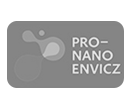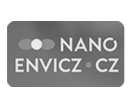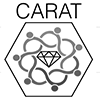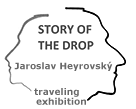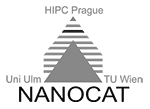Project CARAT

Project name: CARAT
Carbon allotropes with rationalized nanointerfaces and nanolinks for environmental and biomedical applications
Project provider: Ministry of Education, Youth and Sports as the Managing Authority of the Operational Program Research, Development and Education.
Area of support: Long-term Intersectoral Cooperation
Project leader: RNDr. Ing. Martin KALBÁČ, Ph.D.
Project registration number: CZ.02.1.01/0.0/0.0/16_026/0008382
Total project cost: 90 685 819,01 Kč
Co-financing rate from the European Social Fund: Co-financing rate from the European Regional Development Fund: 75,9 %
Acronym: CARAT
Realization time: 1. 10. 2018 - 31. 12. 2022 (51 month)
The main objective of the project is to establish and implement intensive long-term cooperation between academic and commercial partners for the purpose of high-level research with a significant impact on areas determining the quality of human life: saving energy, the environment and human health. The proposed research strategy aims to rationalize communication channels (interfaces and nanolinks) in hybrid and sensor structures based on optimized carbon allotropes for enviro and bio applications. This synergy is motivated by a number of critical scientific questions about the implementation of carbon nanomaterials in specific applications. At the same time, the goal is to create a sufficiently diverse expert team that will be able effectively communicate at a deep professional level, thus promoting existing technological and creative processes in the project's scientific interest. The research strategy of the project builds on a fresh approach to material design, through the rationalization of communication channels - interfaces and nanolinks. Carbon allotropes are selected as a highly desirable sub-materials, namely graphene (and derived graphenoids) and nanocrystalline diamond. Partial scientific goals in the graphene branch are to achieve optimization of structural and topographic parameters of native and functionalized graphene, graphene and substrate interaction (metal, dielectric, and semiconductor) and lithographic processes for gentle structuring. The ultimate goal is the realization of robust sensors and printed electronic functional structures on the platform of modified and structured graphenoids for the detection and quantification of environmental parameters. The diamond branch is aimed at optimizing the deformation diamond-defined diamond preparation, which serves as a precursor to the implementation of in vitro and in vivo sensors with extreme time-spatial resolution and intracellular nanosensors based on spin entities. In addition, significant enhancement of hybrid homocomposite parameters is expected based on selectively coupled sp2 and sp3 forms of nanocarbon. The long-term goal is to maintain the established cooperation and the definition of new research activities, especially in the line of detonation processes and lithographic technologies, beyond the group of materials that are the subject of research in the project.
Partners:
TESLA BLATNÁ, a.s.
ZČU
MFF UK
UOCHB
FZÚ
The European Union financially supports this project.
Publications:
- Extremely rapid isotropic irradiation of nanoparticles with ions generated in situ by a nuclear reaction - PubMed (nih.gov)
- Introducing Well-Defined Nanowrinkles in CVD Grown Graphene - PubMed (nih.gov)
- Sculpturing graphene wrinkle patterns into compliant substrates - ScienceDirect
- Not All Fluorescent Nanodiamonds Are Created Equal: A Comparative Study - Reineck - 2019 - Particle & Particle Systems Characterization - Wiley Online Library
- Inhibitor–Polymer Conjugates as a Versatile Tool for Detection and Visualization of Cancer-Associated Carbonic Anhydrase Isoforms (acs.org)
- Superlattice in collapsed graphene wrinkles | Scientific Reports (nature.com)
- Strong and efficient doping of monolayer MoS 2 by a graphene electrode - PubMed (nih.gov)
- On the Suitability of Raman Spectroscopy to Monitor the Degree of Graphene Functionalization by Diazonium Salts | The Journal of Physical Chemistry C (acs.org)
- Decomposition of Iron Pentacarbonyl Induced by Singly and Multiply Charged Ions and Implications for Focused Ion Beam-Induced Deposition (acs.org)
- Effect of thermal history on magnetism in UCoGa - ScienceDirect
- Diamond nano-optode for fluorescent measurements of pH and temperature - Nanoscale (RSC Publishing)
- Transferless Inverted Graphene/Silicon Heterostructures Prepared by Plasma-Enhanced Chemical Vapor Deposition of Amorphous Silicon on CVD Graphene - PubMed (nih.gov)
- UV/VIS spectroelectrochemistry with 3D printed electrodes - ScienceDirect
- 3D printed polylactic acid/carbon black electrodes with nearly ideal electrochemical behaviour - ScienceDirect
- The Effect of the Orientation Towards Analyte Flow on Electrochemical Sensor Performance and Current Fluctuations - CORE
- Nanomaterials | Free Full-Text | Understanding Magnetization Dynamics of a Magnetic Nanoparticle with a Disordered Shell Using Micromagnetic Simulations (mdpi.com)
- Large scale chemical functionalization of locally curved graphene with nanometer resolution - ScienceDirect
- Simultaneous label-free live imaging of cell nucleus and luminescent nanodiamonds - PubMed (nih.gov)
- Nanoscale Dynamic Readout of a Chemical Redox Process Using Radicals Coupled with Nitrogen-Vacancy Centers in Nanodiamonds | ACS Nano
- Nanomaterials | Free Full-Text | Recent Advances of Graphene-Derived Nanocomposites in Water-Based Drilling Fluids (mdpi.com)
- Hierarchy of nanoscale graphene wrinkles on compliant substrate: Theory and experiment - ScienceDirect
- Carbon | Vol 173, Pages 1-1114 (March 2021) | ScienceDirect.com by Elsevier
- Attoliter Chemistry for Nanoscale Functionalization of Graphene | ACS Applied Materials & Interfaces
- IJMS | Free Full-Text | 5-Nitro-2,4-Dichloropyrimidine as an Universal Model for Low-Energy Electron Processes Relevant for Radiosensitization (mdpi.com)
- Growth defects in WC:H layers for tribological applications - ScienceDirect
- In-depth distribution of elements and chemical bonds in the surface region of calcium-doped diamond-like carbon films - ScienceDirect
- Host–Guest Interactions in Metal–Organic Frameworks Doped with Acceptor Molecules as Revealed by Resonance Raman Spectroscopy | The Journal of Physical Chemistry C (acs.org)
- Nanomaterials | Free Full-Text | In Situ Raman Microdroplet Spectroelectrochemical Investigation of CuSCN Electrodeposited on Different Substrates (mdpi.com)
- Strong localization effects in the photoluminescence of transition metal dichalcogenide heterobilayers - IOPscience
- Chemical vapor deposition (CVD) growth of graphene films - ScienceDirect
- Folding DNA into origami nanostructures enhances resistance to ionizing radiation - Nanoscale (RSC Publishing)
- Water-Assisted Electron-Induced Chemistry of the Nanofabrication Precursor Iron Pentacarbonyl | The Journal of Physical Chemistry A (acs.org)
- Harnessing subcellular-resolved organ distribution of cationic copolymer-functionalized fluorescent nanodiamonds for optimal delivery of active siRNA to a xenografted tumor in mice - Nanoscale (RSC Publishing)
- Nanomaterials | Free Full-Text | On the Origin of Reduced Cytotoxicity of Germanium-Doped Diamond-Like Carbon: Role of Top Surface Composition and Bonding (mdpi.com)
- Nanoscale Study of the Hole-Selective Passivating Contacts with High Thermal Budget Using C-AFM Tomography | ACS Applied Materials & Interfaces
- IJMS | Free Full-Text | Reversible Lectin Binding to Glycan-Functionalized Graphene (mdpi.com)
- The use of sample positioning to control defect creation by oxygen plasma in isotopically labelled bilayer graphene membranes - RSC Advances (RSC Publishing) DOI:10.1039/D1RA01249E
- Crystallization of 2D Hybrid Organic–Inorganic Perovskites Templated by Conductive Substrates - Kovaricek - 2021 - Advanced Functional Materials - Wiley Online Library
- Carbon | Vol 179, Pages 1-704 (July 2021) | ScienceDirect.com by Elsevier
- Probing the local dielectric function of WS<SUB>2</SUB> on an Au substrate by near field optical microscopy operating in the visible spectral range - NASA/ADS (harvard.edu)
- Two-Dimensional CVD-Graphene/Polyaniline Supercapacitors: Synthesis Strategy and Electrochemical Operation | ACS Applied Materials & Interfaces
- Quantum Sensing of Free Radicals in Primary Human Dendritic Cells | Nano Letters (acs.org)
- Nanomaterials | Free Full-Text | Mixed sp2–sp3 Nanocarbon Materials: A Status Quo Review (mdpi.com)
- Towards recent tendencies in drilling fluids: application of carbon-based nanomaterials - ScienceDirect
- Nanomaterials | Free Full-Text | Self-Limitations of Heat Release in Coupled Core-Shell Spinel Ferrite Nanoparticles: Frequency, Time, and Temperature Dependencies (mdpi.com)
- Doping of the hydrogen-passivated Si(100) electronic structure through carborane adsorption studied using density functional theory - Physical Chemistry Chemical Physics (RSC Publishing
- Energies | Free Full-Text | Influence of Sweat on Joint and Sensor Reliability of E-Textiles (mdpi.com)
- Energies | Free Full-Text | Simultaneous Detection of NH3 and NO2 by Modified Impedance Spectroscopy in Sensors Based on Carbon Nanotubes (mdpi.com)
- Highly Sensitive Room-Temperature Ammonia Sensors Based on Single-Wall Carbon Nanotubes Modified by PEDOT | IEEE Journals & Magazine | IEEE Xplore
- Dielectric, structural and mechanical properties of thermally aged biaxially oriented polymeric substrates for flexible electronics - ScienceDirect
- Nanomaterials | Free Full-Text | Graphene-Based Temperature Sensors–Comparison of the Temperature and Humidity Dependences (mdpi.com)
- Metastable Brominated Nanodiamond Surface Enables Room Temperature and Catalysis-Free Amine Chemistry | The Journal of Physical Chemistry Letters (acs.org)
- Optically coupled gold nanostructures: plasmon enhanced luminescence from gold nanorod-nanocluster hybrids - Nanoscale (RSC Publishing) DOI:10.1039/D1NR08254J
- Visualization of Sentinel Lymph Nodes with Mannosylated Fluorescent Nanodiamonds - Kvakova - 2022 - Advanced Functional Materials - Wiley Online Library
- Reversible anion intercalation into graphite from aluminum perchlorate “water‐in‐salt” electrolyte - ScienceDirect
- Chaotropic anion based “water-in-salt” electrolyte realizes a high voltage Zn–graphite dual-ion battery - Journal of Materials Chemistry A (RSC Publishing) DOI:10.1039/D1TA10122F
- Localized Spectroelectrochemical Identification of Basal Plane and Defect-Related Charge-Transfer Processes in Graphene | The Journal of Physical Chemistry Letters (acs.org)
- Different Mechanisms of DNA Radiosensitization by 8-Bromoadenosine and 2′-Deoxy-2′-fluorocytidine Observed on DNA Origami Nanoframe Supports | The Journal of Physical Chemistry Letters (acs.org)
- Nanodiamond Size from Low-Frequency Acoustic Raman Modes | The Journal of Physical Chemistry C (acs.org)
- Anomalous elasticity and damping in covalently cross-linked graphene aerogels | Communications Physics (nature.com)
- Polymers | Free Full-Text | Solvent Evaporation Rate as a Tool for Tuning the Performance of a Solid Polymer Electrolyte Gas Sensor (mdpi.com)








